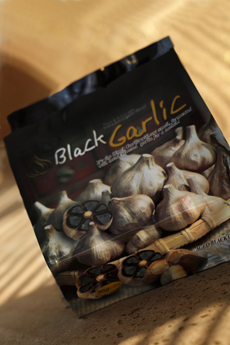Black Garlic
Page 2: How Black Garlic Is Made
This is Page 2 of a four-page article, plus recipes. Click on the black links below to visit the other pages.
How Black Garlic Is Made
Black garlic, also called aged garlic, is regular garlic that has been fermented for a month at low heat to develop a black color (actually, it’s very dark brown) and a sweet-fermented flavor. You can see the difference between black garlic and roasted garlic in the photo.
Garlic contains sugars and amino acids that combine to produce a compound called melanoidin when fermented (this is done with the the chemical phenomenon known as the Maillard reaction).*
*If you’re into science, the color comes from a reaction between the sugar and an amino acid in the garlic. Called the Maillard (my-YARD) reaction after the French physician and chemist Louis Camille Maillard, it’s a form of non-enzymatic browning that usually requires heat. Each type of food has a very distinctive set of flavor compounds that are formed during the Maillard reaction. The color and flavor of toasted bread and nuts; barbecued, roasted and seared meats; and roasted coffee (and many others) are the result of Maillard reactions. Thus caramel candy is the result of a Maillard reaction, the process called caramelization—the caramelization of sugar, as opposed to the creation of the candy—is not a Maillard reaction but a different type of non-enzymatic browning, not involving amino acids. Instead, the sugar is oxidized.
Black garlic is a natural product: There are no additives. It’s fermented in a special machine that monitors heat and humidity for three or more weeks, while the developing flavor is tasted regularly. When it leaves the machine, it air-dries on racks.
The fermentation of food is a common process in preserving food. It’s used in pickling and to make sour foods (kimchi, sauerkraut, yogurt and vinegar, for example); in the leavening of bread and the production of beer, cider and wine.
What does it taste like? Like garlic cooked with tamarind-molasses-balsamic-soy sauce flavor.
What to do with it? While some people find the taste can be too intense, we find that the flavors of black garlic are easily overwhelmed with other ingredients. When using the same amount of fresh garlic, for example, the black garlic flavor disappeared into the other flashy flavors of pesto. But it showed itself off, subtly, when added to a neutral-tasting dish like hummos.
That’s why we’ve learned to keep it simple:
- Add slices to salads
- Place slices atop broiled salmon or halibut
- Serve a whole clove with steak or chops
- Add it to dips—try it in hummus and tapenade
- Toss slices with pasta
- Make a compound butter
- Try some muddled in a vinaigrette
- Add to a white wine sauce
Note that you can simply replace black garlic where you would use roasted garlic and be just as happy with the flavor. We, however, wanted to try to take advantage of its more complex flavor, dramatic color and firmer texture. Follow us to Page 3 and Page 4 for two recipes.
BLACK GARLIC
Fermented Garlic Bulbs
- Two-Bulb Bag
$3.99
- Five-Ounce Tub Of Peeled Black Garlic
$10.99
Purchase online* at BlackGarlic.com or Amazon.com.
*Prices and product availability are verified at publication but are subject to change. Shipping is additional. These items are offered by a third party and THE NIBBLE has no relationship with them. This link to purchase is provided as a reader convenience.
|
|

For $3.99 or so, you can try a two-bulb bag. |
Continue To Page 3: Black Garlic Hummus Recipe
Go To The Article Index Above

| 


